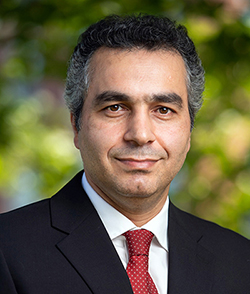CRYPTOGRAPHY AND NETWORK SECURITY
This course provides a broad introduction to a variety of topics in applied cryptography, network security and malwares. It is possible to divide this course into three parts. In the first part which is cryptography, we will cover number theory, symmetric and Asymmetric Cryptography, and other fundamental cryptographic constructs. Second part namely network security covers underlying concepts and foundations of computer network security, from basic knowledge about security to complex secure techniques. Third and last part is focusing on Viruses, malwares, intruders and firewalls.
ORGANISATION
Language: The class is taught in English.
Assistant: Select one student to manage, handle and collect the assignments, projects, and Lab activities.
MidTerm Examination: Written examination, (10%)
Final Examination: Written examination, (50%)
Courseworks: First coursework is compulsory + select one from number 2 or 3, (40%)
Coursework 1: 5 Courseworks (individual) (15% = 5 + 3%)
Coursework 2: A project by JAVA or C++ (Group based) + Presentation, (25%=20% + 5%)
Assistant: Select one student to manage, handle and collect the assignments, projects, and Lab activities.
MidTerm Examination: Written examination, (10%)
Final Examination: Written examination, (50%)
Courseworks: First coursework is compulsory + select one from number 2 or 3, (40%)
Coursework 1: 5 Courseworks (individual) (15% = 5 + 3%)
Coursework 2: A project by JAVA or C++ (Group based) + Presentation, (25%=20% + 5%)
LECTURE NOTES
- Session 1: Introduction to Network Security: Definitions, Computer Security Goals, Additional Goals, Attacks and Threats, Type of Attacks, Security services, Security Mechanism, Network Security Model
- Coursework 1
- Session 2: Symmetric Encryption – Message Confidentiality: Block Cipher, DES, 3DES, AES, Stream Cipher, RC4, Randomness, Symmetric Key Distribution
- Session 3: Asymmetric Encryption – Message Authentication: Message Authentication, One-way Hash Functions, SHA, HMAC, Public-Key encryption structure, RSA, Diffie-Hellman, Digital Signature standard (DSS), Elliptic-curve cryptology (ECC)
- Coursework 2
- Session 4: Network Access Control and Cloud Security: Network Access Control (NAC), NAC Enforcement Methods, Authentication Protocol (AP), Authentication Methods, Cloud Computing, Cloud Computing Reference Architecture, Cloud Provider, Cloud Security Risks, Data Protection in the Cloud, Cloud Security as a Service (SecaaS)
- Coursework 3
- Session 5: Wireless Network Security
- Session 6: Email Security
- Coursework 4
- Session 7: IP Security
- Session 8: Malwar or Malicious software
- Coursework 5
- Session 9: Intruders
- Session 10: Firewalls
- Session 11: Virus, Anti-virus
- Final Project
HANDOUT FOR LAB SESSIONS
- Handout 1: Capturing/Monitoring/Analysing Network traffic
- Handout 2: Capturing/Monitoring/Detecting "Scanning Attack"
- Handout 3: Capturing/Monitoring/Detecting "Btute Force Attack"
- Handout 4: Capturing/Monitoring/Detecting "MITM Attack"
- Handout 5: Capturing/Monitoring/Detecting "DoS Attack"
- Handout 6: Capturing/Monitoring/Analysing "Botnet Behaviour"
- Handout 7: Capturing/Monitoring/Analysing "Malware behaviour"


